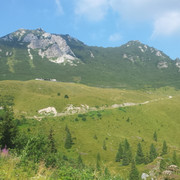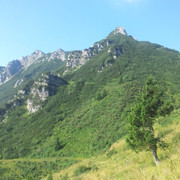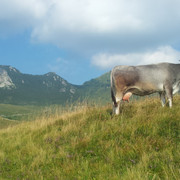From Tolmezzo the trail follows the “Sentiero della Fede” (path of faith) to Fielis, through the hamlets of Casanova, Cazzaso, Sezza and the church of San Pietro di Carnia. It then continues west, climbing to Arta Terme and then down to Ovaro.
Detailed route description

From Tolmezzo cross the But stream via the old bridge between the Carnia region’s main town and Caneva and head right towards Casanova (348m). Here the walker embarks upon the “Sentiero della Fede” (trail of faith) that links Tolmezzo and the Shrine of Maria Luggau in Lesachtal valley in Carinthia (Austria). The broad trail leads to Cazzaso (675m) and Sezza (648m); near the cemetery the trail heads right down to the gully of the Bueda stream. A magnificent, single-arched stone bridge leads across to the church of San Pietro di Carnia (749m), from where there are stunning views over the whole of the But valley and the wild mountains of the eastern Carnia region. Continue northwards towards Fielis (820m) where the trail 157veers determinedly west to the Malga Dauda hut (1413m), which is not staffed. At the Malga Meleit hut the trail circles the northern slopes of Mount Arvenis to reach the Malga Arvenis hut (1602m). A broad track then leads to the village of Ovaro (567m).
(Regione Friuli Venezia Giulia)
Natural and cultural heritage

At Invillino there are a number of old churches to be seen, and at Illegio there is a mill and a church. Lake Verzegnis is very picturesque. There is a trail here that dates back through the ages, the “Sentiero della Fede” (trail of faith), which runs through the valley of the Bût stream, turning off towards Ravascletto and Forni Avoltri at Cercivento and ending at the Shrine of Maria Luggau in the Lesachtal area of Carinthia. From Cercivento the “Via Julia Augusta” (Julius Augustus Way) has been restored, and it climbs to the upper Bût valley and through the Mount Croce Carnico pass to Carinthia, and the Gail valley. There are many reminders along the way of the presence here of man, ranging from the Celts through to the Great War. Still in the valley of the Bût stream is Zuglio, the most important historic centre in the Carnia region because of the Roman remains, (housed in a museum), but especially because of the Church of San Pietro which dates from 1300, considered the most important of all the churches in the Carnia region, built in the Carnian gothic style. On the feast of the ascension every year the ritual of the Bacio delle Croci (kiss of the crosses) takes place. The crosses are brought here from all the churches in the Carnia region and are decorated with white ribbons belonging to the children that have been baptized that year. Arta Terme is a well-known spa centre. Sutrio is an important centre for the production of traditional furniture and, from December to the Epiphany, holds an exhibition of artistic nativity scenes. At Cercivento one of the oldest watermills is open to visitors. In June there is a festival where “Cidulis” (small larchwood wheels set alight) are thrown into the water. Further on is Ravascletto, a typical mountain village and a favourite with day-trippers. The last weekend in June is the “Festa celtica notturna” (night time Celtic festival). Paularo, in the intersecting valley of the Chiarsò stream, is arguably the area that is most typical of the Carnia region due to its picturesque valley, the villages, the houses, the streams and the woods. Throughout the Carnia region a sort of cuisine has developed which, though based on traditional recipes, makes room for interesting twists on an old theme.
(Regione Friuli Venezia Giulia)
Useful topographic maps
-
013 ~ TABACCO (1:25000)
-
Foglio A ~ TABACCO - Carnia Trekking (1:25000)
Useful guidebooks
-
Andar per monti in Friuli Venezia Giulia ~ Istituto Geografico de Agostini (ISBN 88.402.9640.9)
-
Alpi Carniche, vol. I ~ CAI - TCI (ISBN 88.365.0344.6)
-
Via Alpina Gelber Weg, Evamaria Wecker ~ Bruckmann (ISBN 978-3-7654-4858-7)
Last update : 2012-05-30

 |
14h10 |
38 km
|
1316 m
|
1050 m
|
14h10 |
38 km
|
1316 m
|
1050 m





















Favourites, criticisms ? Make your personal comments on this stage. For more general notes please use the comments section of the page Over to the Via Alpinists.